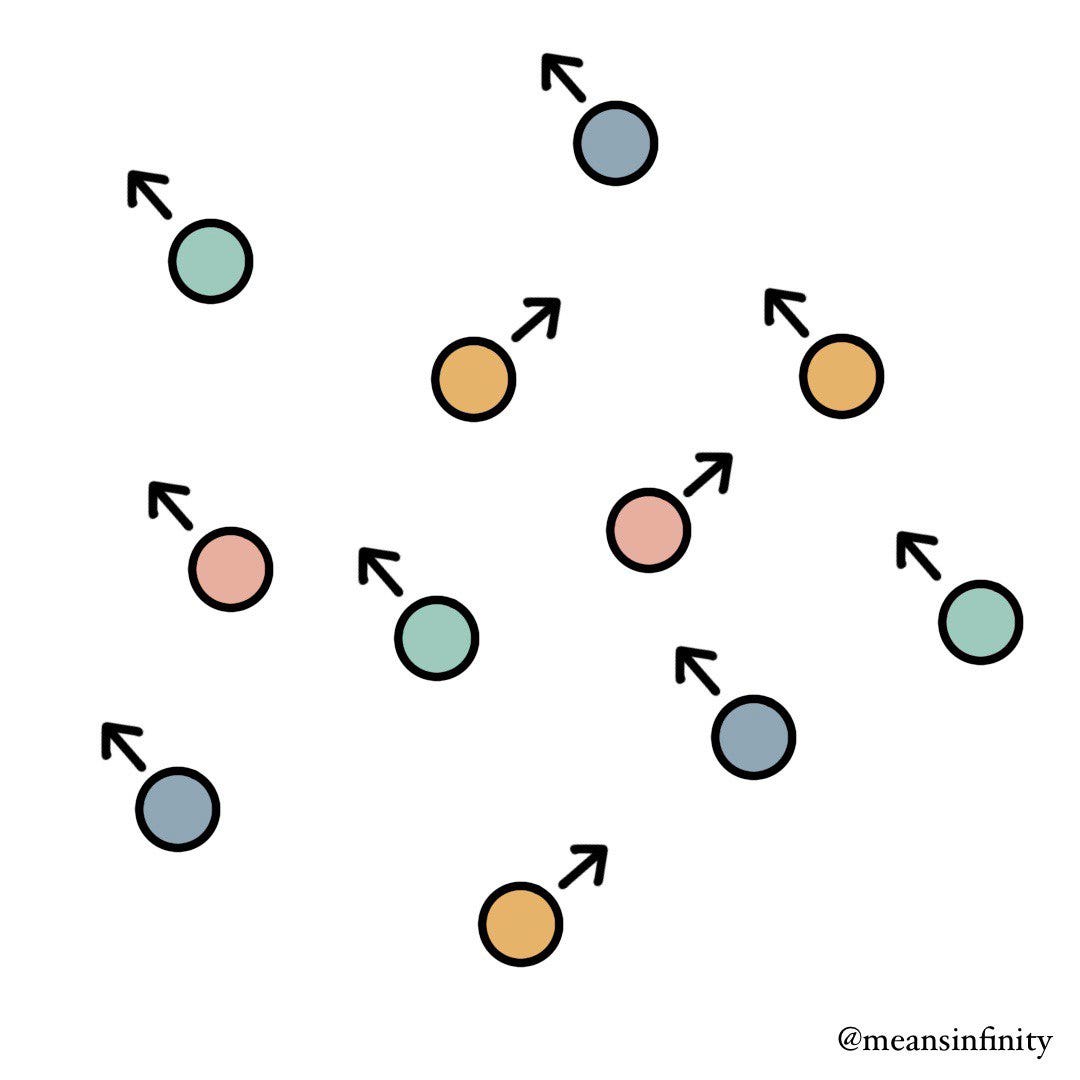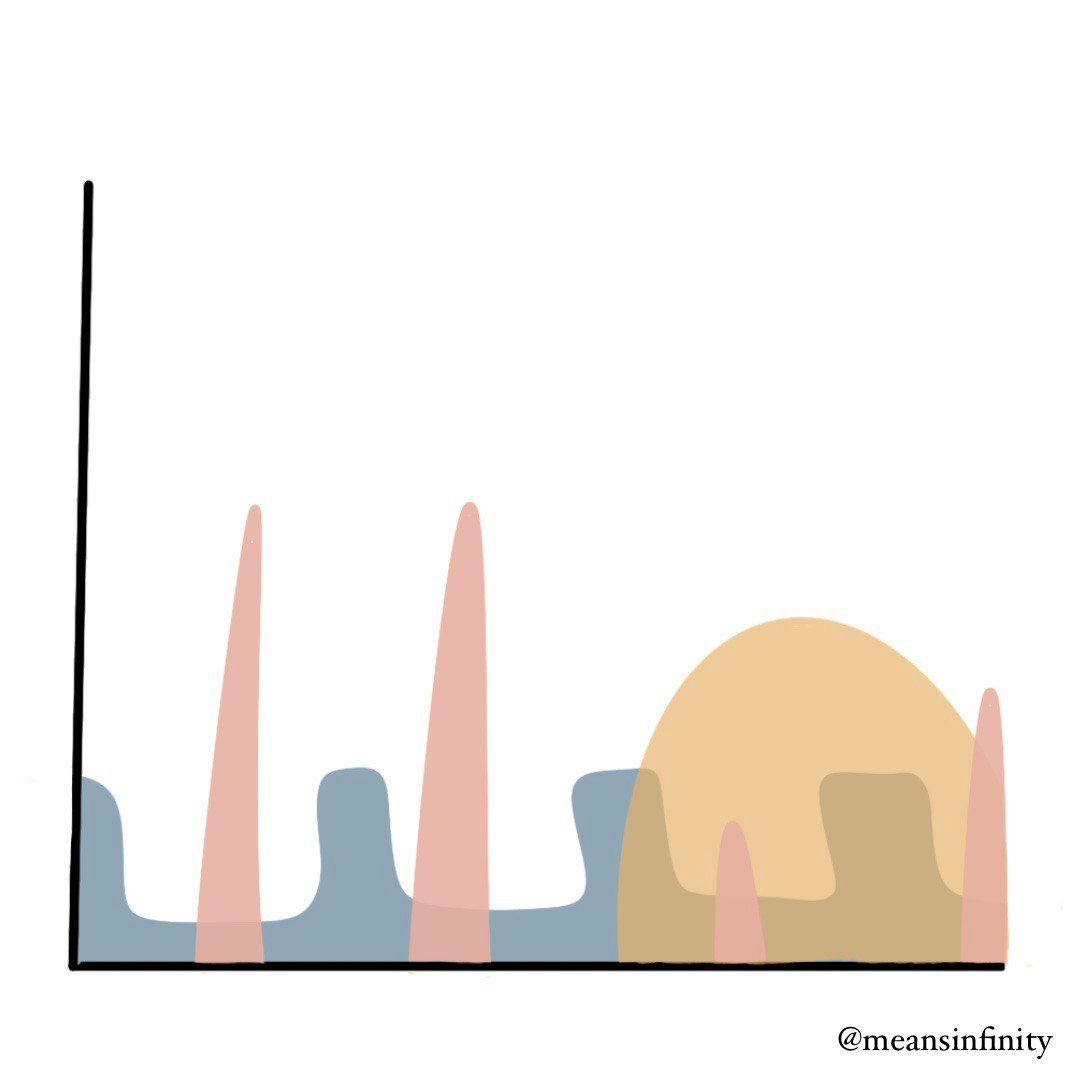You’ve probably felt it. That electric buzz at the start of a co-created gathering. The people are inspiring. The conversations are alive. The air is thick with possibility. And then…it unravels. The kitchen’s a mess. No one’s sure what’s happening when. The spark fades into confusion, frustration, and strain.
Co-created spaces are blooming everywhere right now: experimental residencies, pop-up villages, creative houses, coworking experiments. People are gathering around shared values, curiosity, and the hope of doing something meaningful together.
But if you’ve been part of them, you know the magic and the mess often come tangled up together. Roles are fluid. People come and go. Leadership is diffuse. Priorities are all over the map. Without the right scaffolding, even the best-intentioned gatherings can flounder.
Over the last three years, I’ve been exploring what helps these groups find their footing and create together. I’ve designed or participated in 14 immersive, co-created containers—from five-day camps to multi-month residencies to whimsical, semi-permanent third spaces. Some sparked lasting projects, creative momentum, and life-changing connections. And some felt like swimming in glue.
The groups that flourished shared one thing in common: coherence.
Coherence is a subtle alignment that lets a group move as one. Like a body, where each part moves independently but stays in sync with the whole. When it’s there, creativity flows and people take initiative. When it’s missing, momentum grinds to a halt.
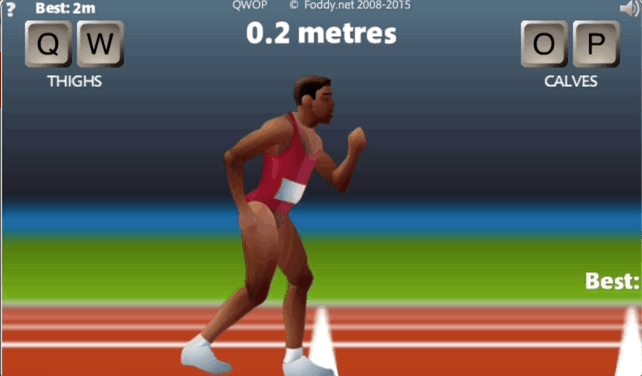
When co-created gatherings flow well, the group’s coherence can look effortless. It’s easy to miss what’s actually holding things together. I’ve seen many organizers—myself included—assume that if you gather the right people, things will just work. It can be a rude awakening when no one cooks dinner, people disengage, or creative momentum fizzles.
In this post, I want to name some of the invisible influences I’ve learned to watch for over years of trial and error. They have had an outsized impact on coherence across the spaces I’ve hosted and joined. I will summarize them in the chart below, and explain them in detail in the next section.
All the examples I share in this post are real patterns I’ve seen in at least two gatherings—many from my own. If one sounds like yours, you’re not alone :)
This post is written for fellow stewards and aspiring stewards of co-created containers, but the dynamics it explores can surface in other kinds of gatherings as well.
In emergent spaces, organizers often downplay their own influence. “I’m not leading…it’s co-created.” But in my experience, a gathering’s coherence always starts with the coherence of its organizer. Unresolved tensions in the organizer’s inner landscape seep into design decisions and become uncomfortable undercurrents in the group atmosphere. I’ve found that maintaining inner clarity is one of the most effective ways to avoid muddying the group dynamic.
Unresolved internal conflicts
Even a small internal conflict in the organizer will show up in the group. This tends to happen most when two values are pulling in opposite directions. Here are some examples.
It’s normal to hold competing values. The important thing is to reconcile them in yourself, so the group doesn’t have to.
It’s helpful to have an introspective practice that surfaces these contradictions. When your values pull in different directions, decide which one takes priority for this container. Be honest about which values can’t coexist. Pay special attention at decision points, like choosing who to invite or whether to bend a rule. These moments often reveal where your values are in conflict.
Of the five influences in this post, this one is the easiest to miss. It asks you to notice your own blindspots: competing desires, mixed motives, even guilt. But holding clear boundaries in every design choice protects the group’s coherence.
The people in the room set the foundation for what’s possible. Coherence strengthens when their intentions and dynamics resonate with the gathering’s purpose. It’s not about homogeneity, but about alignment. When that alignment is missing, the group drains bandwidth managing itself.
Misaligned intentions
Including people whose intentions don’t match the container’s purpose creates incoherence, even if they’re otherwise a great social fit. For example, coworking gatherings often struggle when they include people who primarily want to vibe. The space drifts toward hanging out, and those who come to work lose momentum.
In smaller groups (under ~30), this effect magnifies. A single misalignment can pull the whole group off course. In one gathering I hosted, the container was designed as a slow, restorative New Year’s retreat. But one participant arrived in full “let’s hustle” mode, eager to work and push forward. It created a tension the group had to manage: stay true to the slow, spacious vibe, or adjust to include his pace. He, meanwhile, felt unwelcome. No one was wrong, but the mismatch strained the experience for all involved.
Losing sight of the whole
A common blind spot is curating a guestlist based on individual merit, without considering how people resonate as a group. It’s easy to assume that adding more “great people” will strengthen the group. But coherence depends on how individuals complement each other, not just on their solo strengths.
It’s like building a chord: every note might sound beautiful on its own, but not every combination creates harmony. Add an F# to a C major chord (C, E, G), and the whole thing clashes. On the other hand, stacking C, C, E, and C might harmonize, but it lacks depth.
The kind of balance needed shifts with group size. In larger containers, group composition is mostly about balancing backgrounds and intentions across the whole group. In smaller containers, the dynamics between individuals matter more directly.
Before inviting anyone, get clear on the purpose of the container and prioritize any competing goals. Once aligned, craft an invitation that signals who it’s for, and just as importantly, who it’s not for.
When selecting participants, consider their intention. The clearer the match between their desires and the space’s purpose, the easier it is to sustain coherence.
The stronger your intention, the more deliberately you should select for it. For a focused event with a clear outcome, it helps to ask everyone—even obvious fits—to reflect on their goals. Application forms aren’t just for filtering. They align the group around shared intent.
Once the group is formed, make individual intentions visible. Intro sessions, directories, bios, even a sticky note wall of “what I’m here for” can help the group align around itself. If the group ever feels scattered or out-of-sync, these are handy interventions.
It’s hard to build on shaky ground.
Grounding is about creating a container that feels stable, predictable, and easy to navigate. Without it, groups lose energy to confusion, hesitation, and low-grade coordination work. But when the frame is steady, people can stop managing the space and start building inside it.
Grounding rests on three core elements:
Predictability and rhythm: a steady pulse that anchors the group
Coherent arcs: a shared timeline that aligns group energy
Legibility and minimum structure: enough clarity to know what’s happening, how to plug in, and how to surface and resolve tensions
Inconsistent rhythm
Many containers rely on a single anchor, like a weekly meeting, that gets skipped if there’s no urgent content to share. Or the time keeps shifting. Or people stop showing up. But rhythm isn’t just about content, it’s about orientation. Without a shared cadence, people drift. They start to feel disoriented and disconnected from the group, like a string quartet where each player picks their own tempo.
Competing arcs
In longer containers, spiky events-within-the-event can throw off the group’s shared rhythm. A festival that interrupts a residency. A burst of guests in a slow-build house. These moments can scatter the group’s attention, making it hard for long-term residents to settle and for short-term visitors to feel like they belong. It takes special care to weave together these overlapping group journeys.
Avoiding structure entirely
Sometimes organizers avoid structure because they want things to stay emergent. But emergence still needs scaffolding. If no one knows when dinner is, who’s hosting cleanup, or how to opt into an offering, people freeze or burn out. The goal isn’t to control everything, it’s to build just enough infrastructure that the group doesn’t have to think about the container when they want to step up.
Start with one designated touchpoint that fits your container, like a daily meal or announcements meeting, and keep it steady. The group can add or adapt as needed. If people feel scattered or confused, it’s a sign you need more. If touchpoints start feeling like a chore, you might have too many. Beginning with one gives the group a solid anchor without overdesigning.
In fluid containers, clear rhythms are especially important for helping people orient. When gatherings have overlapping arcs—like long-term residents and short-term guests—choosing a primary rhythm and creating intentional entry points helps the whole group stay aligned. In my last residency, guests arrived and departed weekly. To keep the group anchored, we set Mondays as the fixed arrival day, paired with a weekly ritual to mark the transition. In other gatherings where arrivals were ad hoc, the group was in a constant state of reorienting. This persistent low-level chaos frayed the group’s ability to settle, and newcomers often felt like they were landing midstream with no clear way in.
I will leave other structures as a topic for another post, since they are so context dependent. At a minimum, create structures that help guests understand what is happening, when it’s happening, how to participate, how to take initiative, and how to surface issues. The best containers are invisible. If people keep asking logistical questions or making small missteps, use those as breadcrumbs to identify structures that need fortifying.
Weaving relationships is a quick way to build coherence in a group. The more people are connected across different parts of the gathering, the more the group can sense itself as a whole. Trust builds. Coordination flows. The group becomes more than just a collection of individuals.
The depth of connection matters too. A quick hello isn’t the same as solving a problem together. A group’s collective potential scales with the strength and distribution of its relationships.
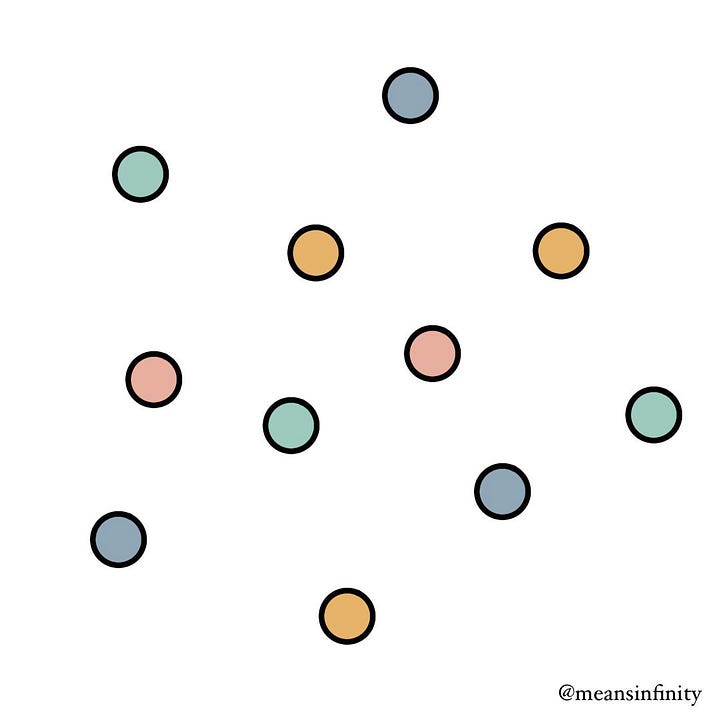
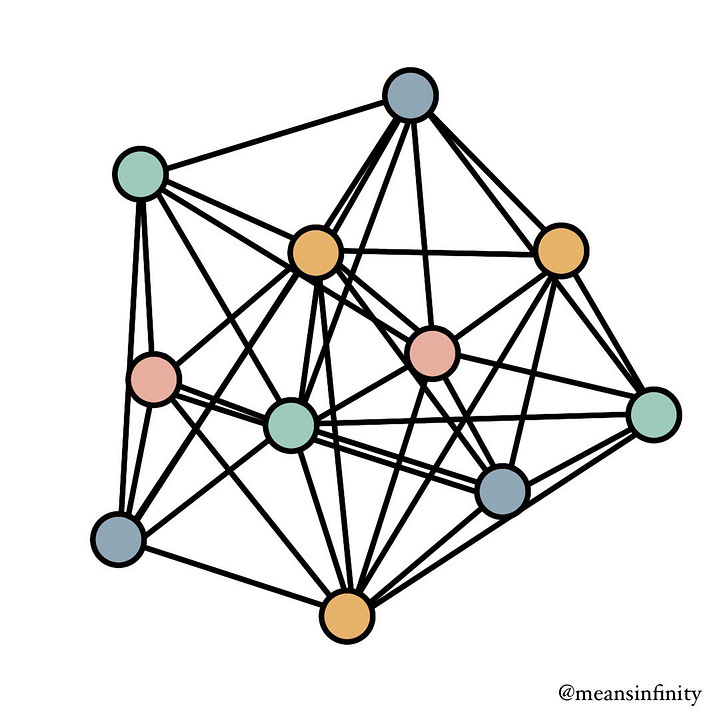
Ignoring the network
One of the most common patterns I see is hosts relying on vibe or curation alone, without creating the connective tissue that helps relationships form across the group. We’ve all seen this happen, for example, at conferences. There are so many incredible people in the room… so why doesn’t anything take off? A high-signal gathering without structural support for interconnection often just diffuses.
Creating awkward network shapes
One common oversight is forgetting to prioritize participants connecting to each other. Sometimes the host has strong personal ties to everyone in the group, but those ties don’t crisscross. Without enough direct connection between members, the group defaults to a hub-and-spoke dynamic. This makes it harder for people to build trust, take initiative, or generate momentum together.
Another common awkward network shape comes from inherited social graphs. If part of the group already knows each other, their shared history will shape the social fabric. It can create an in-group dynamic that’s hard for others to penetrate, or it can serve as a seed of early trust. Either way, it’s worth naming and intentionally balancing or designing around.
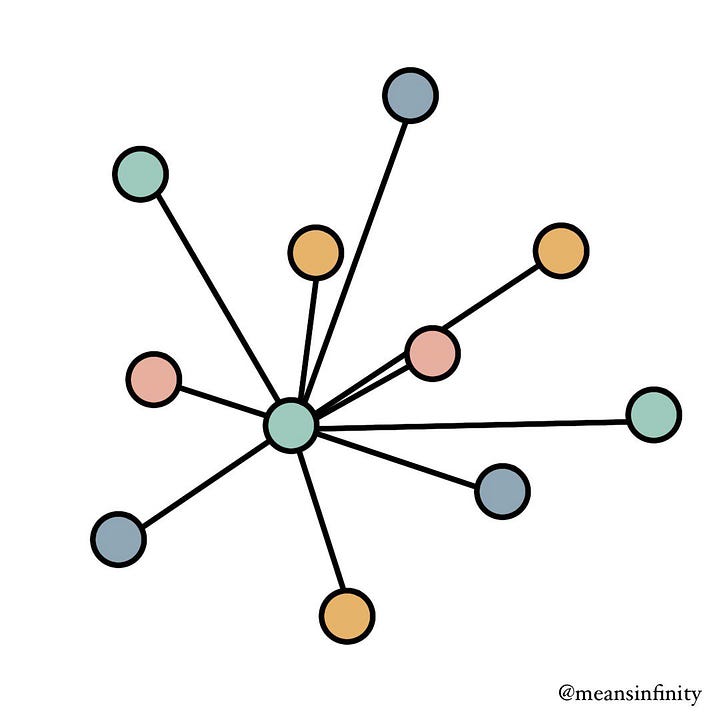
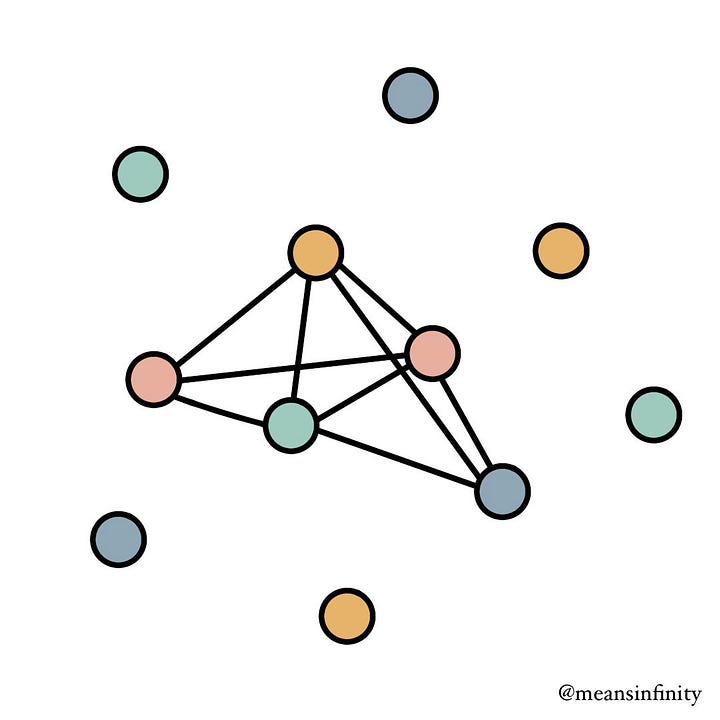
Create excuses for people to interact in small constellations with others they wouldn’t naturally connect with. Do it often, and in a variety of ways. Some classic practices include intro circles, check-ins, and pair shares before larger conversations. But you can also have fun with it! At my last job, I ran a homemade Halloween costume competition where departments teamed up. It was a playful excuse to connect people with their skip-levels.
In co-created environments, participants aren’t usually tracking the group dynamic or looking for ways to densify the graph beyond themselves. They may not have facilitation experience or the intuition to break their workshop into smaller clusters. It helps to model this behavior and to embed some light scaffolding for interaction into the container.
Physical space is not neutral. It signals what’s possible, what’s welcome, and what’s awkward. Like a river shaping the path of a drifting leaf, the space quietly guides how people gather, move, and relate.
Even subtle shifts can change how a group relates. Move a table out of the center of the room and suddenly people start doing morning yoga. Scatter cushions and blankets, and people settle in for slower conversations. Dump a mattress on the floor, and suddenly there’s movie nights and cuddle puddles.
Yet in many gatherings, little attention is paid to how space cues behavior. When space contradicts the purpose of the gathering, it introduces subtle friction the group has to work against. A well-designed space quietly supports group coherence by reflecting the gathering’s purpose.
Fighting the space
The most common spatial issue I see is when the room’s setup clashes with how the group wants to gather. Most people feel more at ease in small group conversations, but spaces are often arranged around a single central hub. That layout creates a kind of gravity. Everyone clusters there by default, even if they would rather spread out. The room is cueing one kind of interaction while the group wants something else.
Over time, I find this mismatch creates ambient tension. People feel restless and pent up, though they might not realize why. Breaking up the hub into smaller pockets and making the central area a little less inviting helps soften its pull. This gives the group more freedom to gather in ways that feel natural. If a big circle is truly wanted, it will still form, but only because someone makes the choice to move a chair.
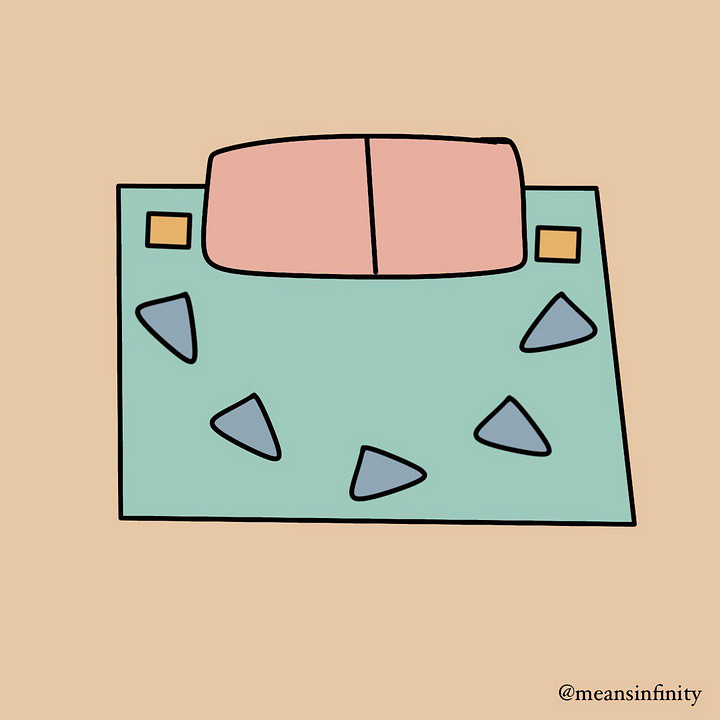
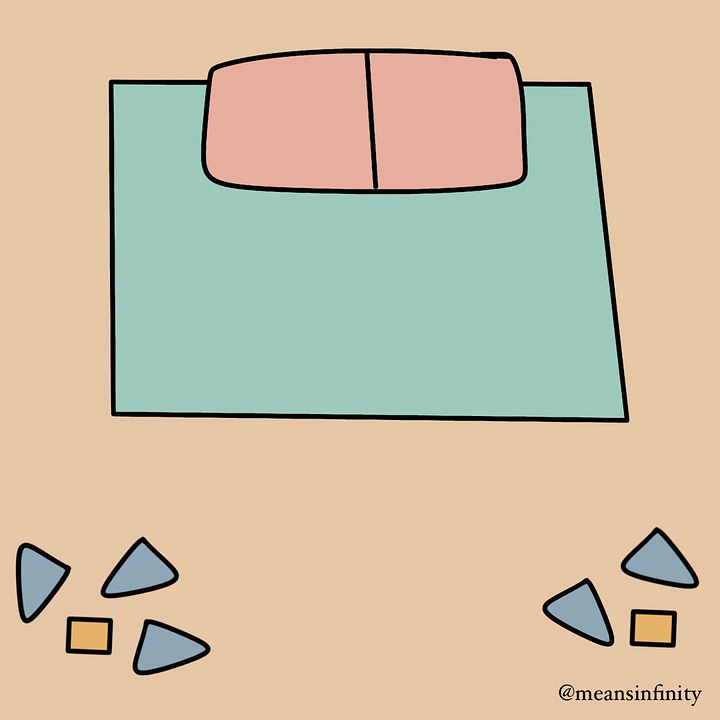
Start by asking: What wants to happen here? And then: How can I arrange the space so that activity feels like the most obvious thing to do?
Take inventory of all the activities the room is meant to support, and give each one a natural home. Make primary activities effortless. Let secondary ones stay possible, but require intention.
Also consider the full range of group needs. Not just functional tasks like coworking, but also things like personal space, and opportunities for low-stakes collisions. Consider space across the full footprint of the venue. If people are sharing bunk rooms with no privacy, it becomes even more important to offer slower, low-pressure common areas where they can reset.
Sometimes needs pull in different directions. You might design for smooth, efficient flow, but later realize the group wants more surface area for serendipity. A little inefficiency, like a bottleneck where people naturally pause, can invite those moments.
Use space as a living lever. As group needs shift, help the space evolve with them. A surprising number of tensions can be softened just by rearranging the room!
Stewarding a decentralized group is rarely about top-down control. More often, it’s about clearing blockages and creating the conditions for flow. These five influences are invisible levers that help a group find its resonance.
There’s no need to optimize every one. Attending to one with care often creates breathing room in others. A strong rhythm can unite a loosely curated group of people. A thoughtfully-designed space can help align people who came with different intentions. A solid curation of self-directed people can weave dense connections, even with minimal support for interconnection.
The point isn’t to be perfectly coherent, but to create minimum viable coherence. A container which supports the group’s desires instead of interfering with them.
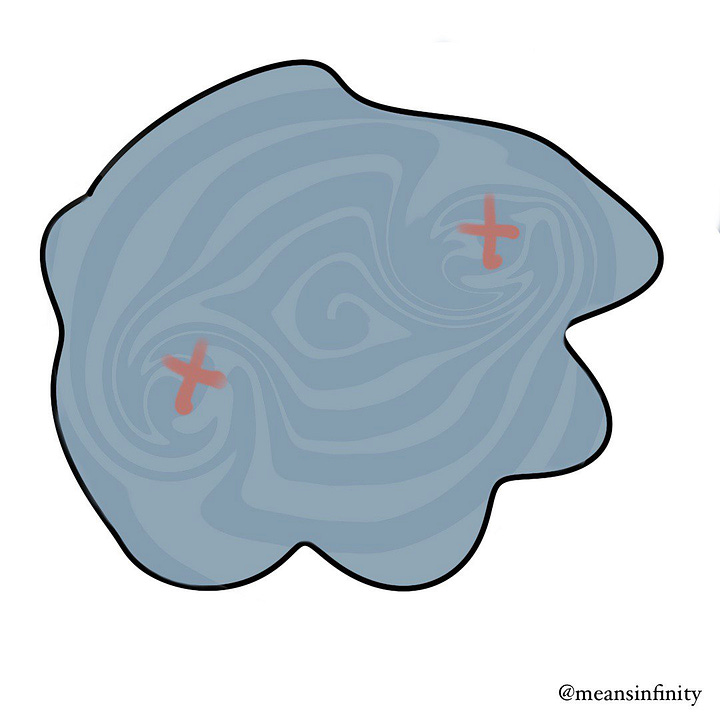
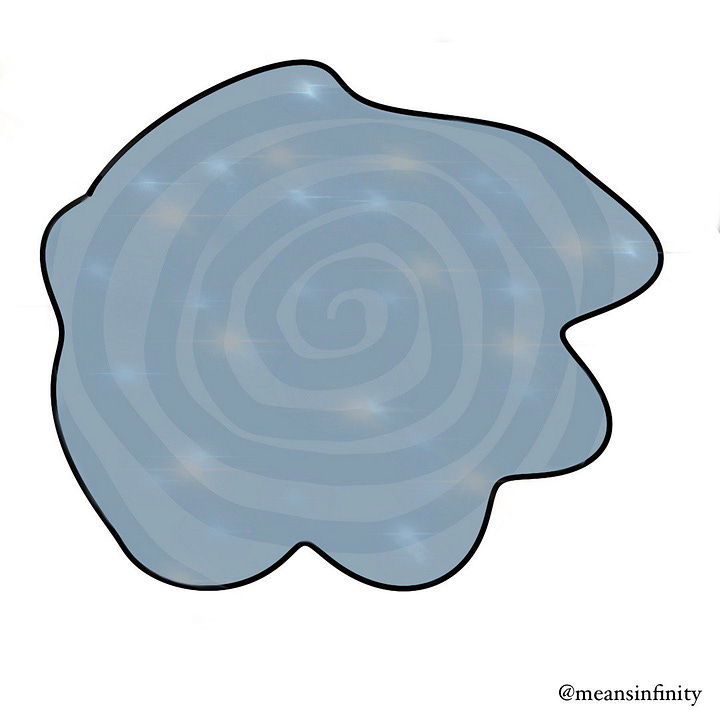
This post shared some of the patterns I’ve been learning in my exploration of co-created spaces, but there’s far more to uncover. Studying these patterns isn’t just about smoother gatherings. It helps us understand how to build groups that are more powerful, more resilient, more creative, and more coordinated. Every co-created gathering is a chance to explore new ways of being together.
I’d love to hear what you’re learning in your own experiments too.
.png)

